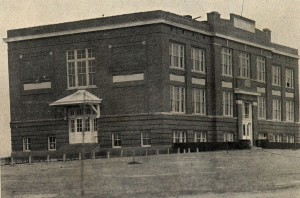Southern Arkansas University (SAU), a comprehensive regional public university, was founded more than a century ago as the Third District Agricultural School (TDAS). The Arkansas legislature approved Act 100 on April 1, 1909, a date celebrated at SAU as Founder’s Day, to establish four secondary residential schools in regional quadrants of the state.
The Arkansas chapter of the national Farmers Educational and Cooperative Union, an organization that embraced the era’s Progressive reform campaign to boost rural economic and social conditions, lobbied fervently to establish the agricultural schools. TDAS was established to serve Southwest Arkansas. Magnolia citizens won the competition for the school by raising $40,000 to match state financing. On January 11, 1911 the new institution’s first term began with seventy-five students and five teachers, although construction continued on the unfinished buildings. TDAS students took classes in scientific agricultural practices, modern home economics, as well as academic subjects that led to a high school degree. The school did not charge tuition but most students worked at various tasks on campus to afford room and board.
The legacy of the Farmers Union continued as the school evolved into a university. SAU operates one of the state’s largest collegiate farms, and the school’s colors—Blue and Gold—are those of the union. SAU’s agricultural roots are also evident in its unique symbol—Muleriders–adopted in 1912 when its football players rode mules, ubiquitous and essential to Southern agriculture, to practice and games. The student yearbook was named The Mulerider in 1922, and the newspaper The Bray in 1923. At each home football game, a student rider on a mascot mule celebrates team successes.
To increase the supply of rural schoolteachers, Arkansas lawmakers in 1925 elevated TDAS and the state’s other residential agricultural schools to junior college status. Officially renamed State Agricultural and Mechanical College, Third District, the school was commonly known as Magnolia A&M. The North Central Association of Colleges and Secondary Schools accredited Magnolia A&M four years later, and the institution maintained continuous accreditation through its later transformations.
In the fall of 1949 the Board of Trustees, exercising authority vested in it by the state legislature, elevated the junior college into a four-year, degree-granting institution. The Magnolia college was the last of the four original farmers’ schools to take this step. In January 1951, the legislature authorized renaming the institution as Southern State College (SSC). The college board had already approved by this point a bond issue that would almost double the physical core of the institution, including the first on-campus football stadium. Enrollment grew from a few hundred students during the junior college years to well over two thousand during SSC’s twenty-five -year history.
On July 9, 1976, SSC became Southern Arkansas University. Legislative action in the previous year had reconfigured the institution into a three-campus system. This act created a community college branch in El Dorado while transferring the Southwest Technical Institute, a Camden institution that offered two-year degrees, from state control to oversight by the SSC (soon SAU) Board of Trustees. In 1992 SAU-El Dorado separated from the system to become free-standing South Arkansas Community College. SAU-Tech remained aligned with the Magnolia campus.
With the arrival of the 21st century, SAU Magnolia welcomed a greater proportion of students into new graduate programs, many of which delivered courses online. In the fall of 2021, 32 students began their pursuit of the Doctor of Education in Rural and Diverse Educational Leadership, the university’s and the region’s first doctoral program. SAU at the beginning of the new century led nearly all Arkansas universities in its percentage of international students. This pattern continued as graduate offerings attracted more applicants from abroad.
SAU also offered the first engineering degree in the lower half of the state. This general bachelor of science in engineering was accredited in 2018 and the university looked to expand the program by developing specialized engineering degrees. The legacy of the university’s origins was evident with the opening in 2013 of the state-of-the-art agricultural center. The 30,000 square foot complex was part of a large-scale construction campaign that transformed the campus following its launch in 2002.
The need for new dormitories arose as SAU drew more students from throughout Arkansas as well as surrounding states. Students admitted to the Honors College, founded in 2002, were invited to live in Honors Hall. Record enrollment levels were spurred by intensive recruitment campaigns as well as innovative programs to lessen the cost of attendance and assist students in reaching career goals.
See also James F. Willis, “Southern Arkansas University (SAU),” in the online Encyclopedia of Arkansas
[http://encyclopediaofarkansas.net/encyclopedia/entry-detail.aspx?search=1&entryID=4140].

